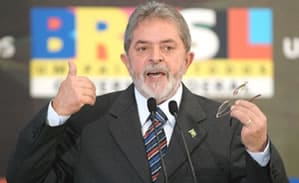After enduring some stormy times, Brazil is beginning to see the results of President Lulas carefulbut sometimes controversialeconomic management.

|
Strong international liquidity, orthodox economic policies and easing interest rates are the winning combination helping the administration overcome the political upheaval unleashed in April 2005 amid allegations that the government, whose campaign platform had centered on fighting corruption, was found to be engaged in some questionable activities. Since then, however, Lulas star, though tarnished, appears to be on the rise again.
Lulas approval rating plummeted from a high of 75% in March 2003 to a low of less than 30% in June 2004, amid concerns over the countrys poor economic performance. After it bounced back to 66% by February of last year as the economy recovered, the political scandal sucked the air out of Lulas reelection aspirations. Since then, however, Brazilians appear to have shifted their attention once again to the economy and are giving Lula an approval rating above 50%and rising.
While Brazils economic growth slowed to 2.5% in 2005 from 4.9% in 2004, growing domestic demand should push growth rates higher this year. In an interview at Januarys World Economic Forum in Davos, Brazilian central bank governor Henrique Meirelles predicted growth would rebound to 4% in 2006, though political observers charge traditional pre-election spending could account for much of the expansion.
Brazils recent economic growth has been fueled by soaring exports. The country posted a record $44.8 billion trade surplus in 2005the largest in Latin America and, on a global scale, surpassed only by Russia and China.
Fiscal responsibility is producing results that will extend beyond the coming election. The budget gap fell to 3.3% of GDP in 2005 from 5.2% in 2003. The government forecasts a primary surplus of 4.25% of GDP for 2006, which Credit Suisse First Boston expects will be closer to 4.4%, compared with last years 4.8%. The situation could give Lula a cushion to increase spending, particularly to address infrastructure needs, without hurting fiscal accounts.
Inflation, Brazils decades-old bogey, is also being tamed. Despite some worrisome spikes in early 2006, inflation fell from 9.3% in 2003 and 7.6% in 2004 to 5.7% in 2005. The governments 2006 target is for 4.5%. People may complain, but we wont give up the fight against inflation because we know that low inflation means money to the poorest portion of the population, says Lula, a former labor activist with a populist agenda.
Unemployment, which will be a key campaign issue, dropped to 8.3% at end-2005, according to the IBGE statistics institute, for the countrys lowest joblessness rate since March 2002. Market estimates had predicted a year-end rate of 9.6%. While some critics said the low figure was the result of new methodology and the seasonal year-end rise in retail and industrial jobs, others countered that the rate only measured urban employment and excluded rural jobs, where the agricultural sector has been booming.
Even skyrocketing global oil prices are unlikely to cause any lasting headaches in Brasilia. After all, the state-controlled Petrobras oil company expects to achieve self-sufficiency this year. Its output rose 12.8% year-on-year in 2005, for average production of 1.68 million barrels per day. The 2006 target is for 1.9 million barrels per day. Petrobras discovered reserves of as much as 1 billion barrels of heavy crude in the Campos Basin in Rio de Janeiro state this year, where it will begin production along with partner Chevron by 2011.
The improved economic situation allowed the government to pre-pay its total $15.5 billion debt with the IMF in January, as well as $2.6 billion in Paris Club obligations. The move will save the government some $900 million in interest charges and will free the country from IMF-mandated policies for the first time in two decades. Brazil, which had already pre-paid another $5.1 billion to the IMF in July 2005, had been the multilaterals largest debtor.
We repaid the money to show the world that this country has a government and it is the owner of its own nose, said Lula after announcing the pre-payment. The government, which had chosen not to renew its IMF program in March 2005, made the pay-off by dipping into its mounting international reserves, which closed 2005 at a high $67 billion.
|
Rate Cuts Ahead |
|||
|
With inflation coming under control, the central bank began easing monetary policy last September, cutting the benchmark overnight Selic rate five times through February. The rate was slashed from a two-year high of 19% in September 2005 to 17.25% in February 2006.
While the rate is Brazils lowest since 2004, it remains one of the worlds highest, which economists warn may hinder sustained growth. Budget minister Paulo Bernardo expects the central bank will cut the rate below the 14.75% that economists are predicting for 2006. The rate has never fallen below 15.25% since it was introduced in 1999.
Market economists are too conservative in their bets, says Bernardo, who believes the expected rate drop will allow the government to trim its net debt to less than 50% of GDP in 2006, compared with 51.65% at end-2005. He also feels it will contribute to a decline in the budget deficit to below 3% this year. The gradual easing of monetary policy wont compromise the important achievements attained in combating inflation and preserving economic growth, policymakers said in their rationale for cutting rates in January. Treasury secretary Joaquim Levy predicts average domestic bond yields may drop to near 12% this year. His outlook was based on the sale of 10-year real-denominated sovereign bonds on international markets at a yield of 12.75%, while also predicting that yields will be driven further downward by foreign investors attracted to the domestic bond market. International investors who look at what has been happening here and compare it with other countries are coming with confidence, explains Levy. To fuel foreign interest in domestic instruments, the government in February approved an exemption on the 15% tax on income and gains on trading of government bonds by foreign investors on the domestic market. Levy says the measure should boost foreign holdings of domestic government paper from $5 billion to as much as $10 billion by next year. Brazils domestic bond market is Latin Americas largest, with R$1 trillion in outstanding issues. Foreigners still represent only a small portion of investors. While the government will forfeit some $100 million in annual tax revenues through the exemption, Levy counters the impact will be offset by lower borrowing costs for the government, as higher foreign participation should push yields on government bonds downward. |
Waiting for the Rating
Authorities are hopeful that a much-awaited investment-grade rating, which some analysts believe could come as early as next year, may be the catalyst for attracting even more foreign investors. Although still high by rating agencies standards, Brazils debt load fell to 51% after the IMF pre-payment, compared with 57% in 2005, putting it closer to a potential upgrade.
In October Moodys upgraded the sovereigns foreign currency rating to Ba3 from Ba1 with a positive outlook, putting it three notches away from investment grade. Moodys argued that a stronger real was making it easier for Brazil to service its foreign currency-denominated obligations. The following month, Standard & Poors revised its outlook to positive from stable.
The continued reduction in public and private sector external debt and impressive export performance reinforce the trend decline in Brazils external debt burden, said S&P; analyst Lisa Schineller. Since then, a government plan to buy back its short-term debt, including outstanding Brady bonds, has further improved its debt standing.
The political scandal pushed many of Brazils much-needed structural reforms to the back burner, as legislators focused on a series of political inquiries. Some analysts in Brazil feel ratings agencies will wait for the scandal to die down and for the reforms to be put back on track before proceeding with an upgrade.
The outcome of the election, with the winner taking office in January 2007, could also be a factor, although few believe there will be a shift in economic strategy away from Lulas fiscal orthodoxy. While polls continue to show the president as the frontrunner for a second term, they also show So Paulo mayor Jos Serra as his strongest potential contender. Serra, a social democrat who lost to Lula in the 2002 race, would likely maintain the economic course.
Meanwhile, as the government awaits a nod from the rating agencies, by February eight Brazilian companies had already been granted an investment-grade rating, thereby easing financing costs. One such company, Companhia Vale do Rio Doce (CVRD), the worlds largest iron ore exporter, went on to complete the largest-ever bond issuea $1 billion, 10-year dealon global markets by a Brazilian corporate.
Votorantim, a diversified industrial conglomerate that is also investment-grade-rated, was granted the largest-ever loan to a private company by the Andean Development Corporation (CAF) in December. The $400 million loan package will allow the company to extend maturities on other outstanding debts.
|
Firing on All Cylinders |
|
Brazilian companies in general sold $2.3 billion worth of bonds abroad in January alone, with the 2006 issuance pipeline filling up quickly. Others are financing growth through the equities market, bringing seven IPOs to the So Paulo Stock Exchange (Bovespa) last year while others prepare to make offerings this year. The Bovespa index posted a 46% 12-month rally in February, setting new highs.
The value of outstanding bank loans also rose by a healthy 13% last year amid a two-year boom in local credit issuance that, despite high interest rates, has been supported by a new bankruptcy law and improvements in credit scorings. The Brazilian Banking Federation (Febraban) predicts another 13% growth in credit issuance for 2006, to R$675 billion. The trend is prompting some banks to step up their local presence. Citigroup, for example, doubled its local branches last year to 124. Manuel Medina Mora, Citigroups Latin America chief, had already announced plans to expand the groups Brazilian activities two years ago. Its a country thats been well managed, Medina Mora said in an interview. Its making progress and we see the economy going well. |




